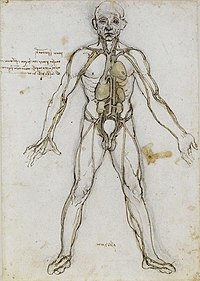
Photo from wikipedia
BackgroundThe aims of this study were to elucidate why the cephalic vein provides a reliable cannulation site from a morphological viewpoint and identify an effective landmark for avoiding injury to… Click to show full abstract
BackgroundThe aims of this study were to elucidate why the cephalic vein provides a reliable cannulation site from a morphological viewpoint and identify an effective landmark for avoiding injury to the superficial branch of the radial nerve (SBRN), allowing for safe venipuncture of the cephalic vein.FindingsWe examined 32 forearms and wrists from 18 cadavers. The cephalic vein was a constant structure containing a branch communicating with a collateral vein of the deep palmar arch via the first dorsal interossei muscle. The metacarpal vein from the medial two digits flowed into the cephalic vein. The venous confluence formed 5.8 ± 1.2 cm proximal to the radial styloid process. The SBRN passed 0.4 ± 0.3 cm volar to the venous confluence. The distance between the venous confluence and subcutaneous emergence of the SBRN was 2.6 ± 1.0 cm.ConclusionsThese observations suggest that the cephalic vein is a constant structure that serves as a drainage vein of the hand and provides a reliable cannulation site in the forearm. The venous confluence may serve as a novel landmark to predict the running course of the SBRN.
Journal Title: JA Clinical Reports
Year Published: 2017
Link to full text (if available)
Share on Social Media: Sign Up to like & get
recommendations!